Unit-2
Laplace Transformation
Let f(t) be any function of t defined for all positive values of t. Then the Laplace transform of the function f(t) is defined as-

Provided that the integral exists, here ‘s’ is the parameter which could be real or complex.
The inverse of the Laplace transform can be defined as below-

Here 
f(t) is called the inverse Laplace transform of 
L is called the Laplace transformation operator.
Conditions for the existence of Laplace transforms-
The Laplace transform of f(t) exists for s>a, if
1. f(t) is a continuous function.
2.  is finite.
is finite.
Important formulae-
1. 
2. 
3. 
4. 
5. 
6. 
7. 
Example-1: Find the Laplace transform of the following functions-
1.  2.
2. 
Sol. 1.
Here 
So that we can write it as-

Now-

2. Since 
Or 
Now-


Example-2: Find the Laplace transform of (1 + cos 2t)
Sol. 




So that-

Inverse Laplace transforms-
The inverse of the Laplace transform can be defined as below-

Here 
f(t) is called the inverse Laplace transform of 
L is called the Laplace transformation operator.
Important formulae-
1.  2.
2. 
3.  4.
4. 
5.  6.
6. 
7.  8.
8. 
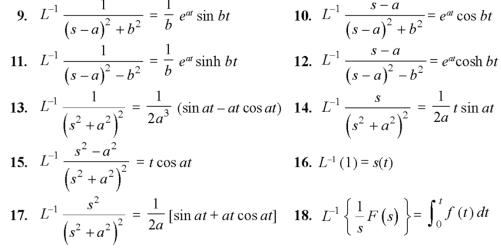
Conditions for existence-
The Laplace transform of f(t) i.e.  exists for s > a, if-
exists for s > a, if-
1. f(t) is continuous
2.  is finite
is finite
Note- the above conditions are sufficient not necessary.
1. Linearity property-
Let a and b be any two constants and  ,
,  any two functions of t, then-
any two functions of t, then-

Proof:


Hence proved.
2. First shifting property (Theorem)- If 

Proof: By definition-

Let (s – a) = r

Hence proved.
We can find the following results with the help of the above theorem-
1. 
2. 
4. 
5. 
6. 
7. 
Here s>a in each case.
Example-1: Find the Laplace transform of t sin at.
Sol. Here-




Example-2: Find the Laplace transform of 
Sol. Here-

So that-




As we know that- 
So that-


Hence-

Example-3: Find the Laplace transform of the following function-

Sol. The given function f(t) can be written as-

So that, by definition,



Change of scale property-

Example: Find-

Given that,

Sol.
By using change of scale property-

Unit step function
The unit step function u(t – a) is defined as-

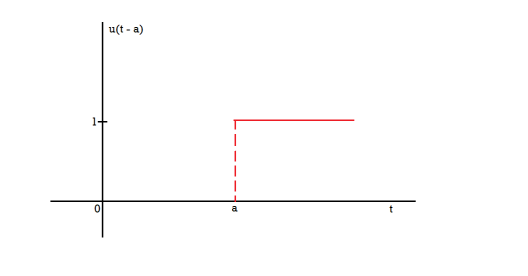
Laplace transform of unit functions-


Example-1: Express the function given below in terms of unit step function and find its Laplace transform as well-

Sol. Here we are given-




So that-

Example-2: Find the Laplace transform of the following function by using unit step function-

Sol. 

Since 


Second shifting theorem-
If 
Then,

Proof: 
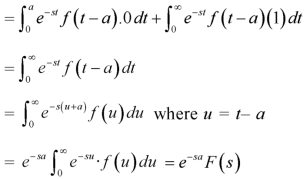
Example-3: Find the Laplace transform of 
Where-

Sol. Here we are given—



As


Unit impulse function
Impulse- When a large force acts for a short time, then the product of the force and the time is called impulse.
The unit impulse function is the limiting function.
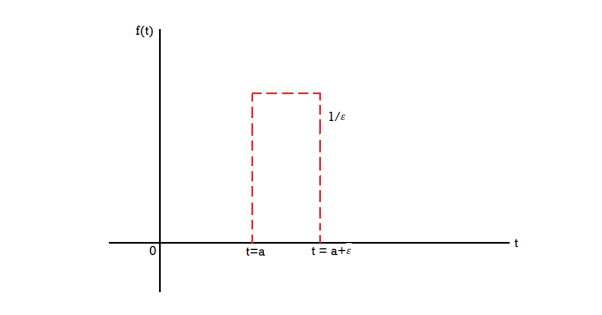

= 0, otherwise
The unit impulse function can be defined as-

And

Laplace transform of unit impulse function-

We know that-
Mean value theorem- 


As  , then we get-
, then we get- 
When  then we have
then we have 
Example-1: Evaluate-
Sol.1. As we know that- 
So that-

2. As we know that-



Example-2: 
Sol. 
Laplace transform of periodic functions-
If f(t) is a periodic function with period T, which means f(t + T) = f(t), then-

Proof: we have-

Put t = u + T in the second integral, t = u + 2T in third integral and so on…
Then-





Laplace transform of the derivative of f(t)-

Here 
Proof: by the definition of Laplace transform-

On integrating by parts, we get-

Since 
Then-

So that-

Laplace transform of integral of f(t) -

Proof: Suppose

We know that-

So that-



Putting the values of  and
and  , we get-
, we get-

Multiplication by  -
-

If 
Then

Proof:
We have


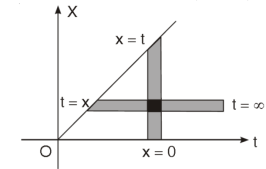
Where the double integral is taken over the infinite region in the first quadrant lying between the lines x = 0 and x = t.
If we change the order of integration, the above integrals changes to-






Hence proved.
Example: Apply convolution theorem to evaluate-

Sol.
Since


By convolution theorem, we get-

Because- f(u) = cos au, g(t-u) = cos b(t – u)



Inverse Laplace transforms-
The inverse of the Laplace transform can be defined as below-

Here 
f(t) is called the inverse Laplace transform of 
L is called the Laplace transformation operator.
Important formulae-
1.  2.
2. 
3.  4.
4. 
5.  6.
6. 
7.  8.
8. 
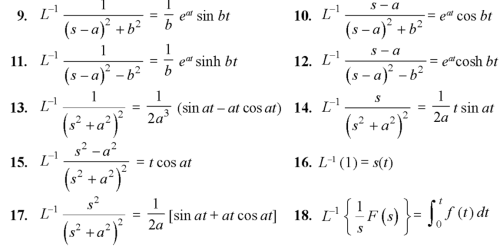
Example: Find the inverse Laplace transform of the following functions-
1. 
2. 
Sol.
1.

2.

Example: Find the inverse Laplace transform of-

Sol.



Multiplication by ‘s’ -

Example: Find the inverse Laplace transform of-

Sol.



Division by s-

Example: Find the inverse Laplace transform of-

Sol.



Inverse Laplace transform of derivative-

Example: Find 
Sol.



Inverse Laplace transform by using partial fraction and convolution theorem
We can find the inverse Laplace transform by using partial fractions method described below-
Example: Find the Laplace inverse of-

Sol.
We will convert the function into partial fractions-




Example: Find the inverse transform of-

Sol.
First we will convert it into partial fractions-


Inverse Laplace transform by convolution theorem-
According to the convolution theorem-

Example: Find

Sol.

Therefore by the convolution theorem-



Step by step procedure to solve a linear differential equation by using Laplace transform-
1. Take Laplace transform of both sides of the given differential equation.
2. Transpose the terms with negative sign to the right.
3. Divide by the coefficient of  , getting
, getting  as a known function of s.
as a known function of s.
4. Resolve the function of s into partial fractions and take the inverse transform of both sides.
We will get y as a function of t. Which is the required solution.
Example-1: Use Laplace transform method to solve the following equation-

Sol. Here we have-

Take Laplace transform of both sides, we get-

It becomes-
(
So that-

Now breaking it into partial fractions-

We get the following results on inversion-


Example-2:Use Laplace transform method to solve the following equation-

Sol.
Here, taking the Laplace transform of both sides, we get

It becomes-


On inversion, we get-


Example-3:Use Laplace transform method to solve the following equation-

Sol. Here we have-

Taking Laplace transform of both sides, we get-

We get on putting given values-

On inversion, we get-


Example-4: Find the solution of the initial value problem by using Laplace transform-

Sol. Here we have-

Taking Laplace transform, we get-

Putting the given values, we get-



On inversion, we get-


 4
4
Now-



